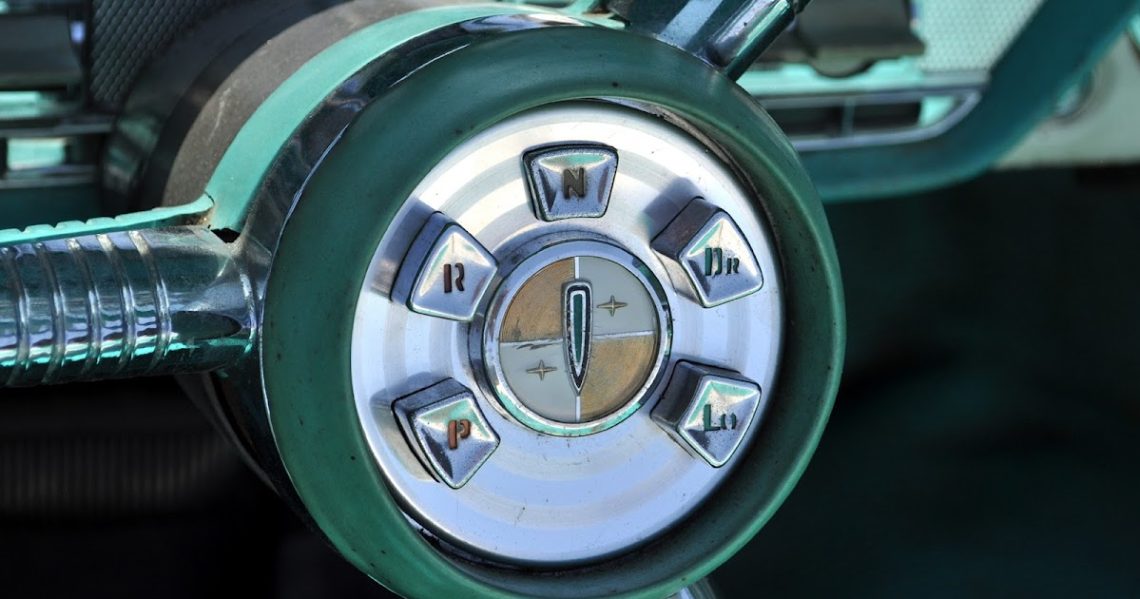The Allure of Push-Button Shifting
The mid-20th century was a time of great innovation in the automotive industry. Designers were constantly looking for ways to improve the driving experience. One such innovation was the push-button transmission. It promised ease of use and a futuristic feel. This article explores the history of American cars with push button transmission, highlighting key models and the reasons behind their rise and eventual fall.
Chrysler’s Pioneering Efforts
Chrysler was a major proponent of push-button transmissions. They introduced the “PowerFlite” transmission with push-button controls in 1956. It was initially offered on models like the Imperial. The system used a series of buttons located on the dashboard. These buttons allowed the driver to select Park, Neutral, Drive, Reverse, and Low. The idea was to simplify the shifting process and free up floor space.
Interesting Fact: Chrysler marketed the push-button transmission as a safer and more convenient alternative to traditional gear levers.
Key Chrysler Models with Push-Button Transmissions:
- Imperial (1956-1964)
- Chrysler Windsor
- Chrysler New Yorker
- Chrysler 300
- Dodge Dart
- Plymouth Valiant
Other Manufacturers and Their Attempts
While Chrysler was the most prominent user, other American manufacturers also experimented with push-button transmissions. Packard, for example, offered the “Ultramatic” transmission with push-button controls in the mid-1950s. Rambler also dabbled in this technology. However, these systems were not as widely adopted or as long-lived as Chrysler’s.
Tip: When researching classic cars with push-button transmissions, always check the specific year and model, as not all vehicles within a particular line had this feature.
The Decline and Fall of Push-Button Transmissions
Despite their initial popularity, push-button transmissions eventually fell out of favor. Several factors contributed to this decline. Reliability issues were a major concern. The complex mechanical and electrical components were prone to failure. Also, the lack of tactile feedback made it difficult for some drivers to feel confident in their gear selection. Finally, the rise of more sophisticated automatic transmissions with improved shift quality made push-button systems seem outdated.
FAQ: American Cars with Push Button Transmission
Q: What were the advantages of push-button transmissions?
A: The main advantages were ease of use, a futuristic design, and freeing up floor space.
Q: What were the disadvantages?
A: Disadvantages included reliability issues, lack of tactile feedback, and eventual obsolescence compared to newer automatic transmissions.
Q: Are there any modern cars with push-button transmissions?
A: While not exactly the same as the mid-century systems, some modern cars use push-button or electronic shifters for gear selection, but these are typically integrated with advanced electronic control systems.
The Allure of Push-Button Shifting
The mid-20th century was a time of great innovation in the automotive industry. Designers were constantly looking for ways to improve the driving experience. One such innovation was the push-button transmission. It promised ease of use and a futuristic feel. This article explores the history of American cars with push button transmission, highlighting key models and the reasons behind their rise and eventual fall.
Chrysler’s Pioneering Efforts
Chrysler was a major proponent of push-button transmissions. They introduced the “PowerFlite” transmission with push-button controls in 1956. It was initially offered on models like the Imperial. The system used a series of buttons located on the dashboard. These buttons allowed the driver to select Park, Neutral, Drive, Reverse, and Low. The idea was to simplify the shifting process and free up floor space.
Interesting Fact: Chrysler marketed the push-button transmission as a safer and more convenient alternative to traditional gear levers;
Key Chrysler Models with Push-Button Transmissions:
- Imperial (1956-1964)
- Chrysler Windsor
- Chrysler New Yorker
- Chrysler 300
- Dodge Dart
- Plymouth Valiant
Other Manufacturers and Their Attempts
While Chrysler was the most prominent user, other American manufacturers also experimented with push-button transmissions. Packard, for example, offered the “Ultramatic” transmission with push-button controls in the mid-1950s. Rambler also dabbled in this technology. However, these systems were not as widely adopted or as long-lived as Chrysler’s.
Tip:
When researching classic cars with push-button transmissions, always check the specific year and model, as not all vehicles within a particular line had this feature.
The Decline and Fall of Push-Button Transmissions
Despite their initial popularity, push-button transmissions eventually fell out of favor. Several factors contributed to this decline. Reliability issues were a major concern. The complex mechanical and electrical components were prone to failure. Also, the lack of tactile feedback made it difficult for some drivers to feel confident in their gear selection. Finally, the rise of more sophisticated automatic transmissions with improved shift quality made push-button systems seem outdated.
FAQ: American Cars with Push Button Transmission
Q: What were the advantages of push-button transmissions?
A: The main advantages were ease of use, a futuristic design, and freeing up floor space.
Q: What were the disadvantages?
A: Disadvantages included reliability issues, lack of tactile feedback, and eventual obsolescence compared to newer automatic transmissions.
Q: Are there any modern cars with push-button transmissions?
A: While not exactly the same as the mid-century systems, some modern cars use push-button or electronic shifters for gear selection, but these are typically integrated with advanced electronic control systems.
Engineering and Operational Nuances
The engineering behind these push-button systems was more complex than a simple cable linkage. Early Chrysler implementations, for instance, often relied on a series of solenoids and electrical relays to actuate the transmission’s valve body. This electromechanical approach, while innovative for its time, introduced numerous potential failure points. Corrosion, faulty wiring, and solenoid malfunctions could all render the transmission inoperable. Furthermore, the lack of a direct mechanical connection between the driver and the transmission diminished the driver’s sense of control, particularly during emergency maneuvers or adverse weather conditions.
The operational characteristics also differed significantly from conventional automatic transmissions. Shift quality could be inconsistent, with noticeable delays or abruptness during gear changes. This was partly due to the limitations of the control systems and the hydraulic characteristics of the transmissions themselves. Modern automatic transmissions, with their sophisticated electronic controls and adaptive learning algorithms, offer a far smoother and more refined driving experience.
The Collector’s Perspective
From a collector’s standpoint, American cars with push button transmission represent a fascinating chapter in automotive history. They embody the optimism and technological exuberance of the mid-20th century. However, owning and maintaining these vehicles presents unique challenges. Parts availability can be limited, and specialized knowledge is often required to diagnose and repair the complex transmission systems. Restoration projects can be both time-consuming and expensive.
Collector’s Note: When acquiring a classic car with a push-button transmission, prioritize vehicles with well-documented maintenance histories and consider a thorough inspection by a qualified mechanic specializing in vintage automobiles.
Despite the challenges, the allure of these vehicles remains strong. Their distinctive styling, coupled with the novelty of the push-button transmission, makes them a unique and desirable addition to any collection. They serve as a tangible reminder of a time when innovation was paramount and the future of driving seemed limitless.
Legacy and Influence
While the push-button transmission itself is largely a relic of the past, its influence can still be seen in modern automotive design. The concept of simplifying the driving experience and reducing driver workload continues to drive innovation in areas such as automatic emergency braking, adaptive cruise control, and autonomous driving systems. The push-button transmission, in its own way, paved the path for these advancements by challenging conventional thinking and exploring alternative approaches to vehicle control.
Perspective:
The story of the push-button transmission serves as a valuable lesson in the automotive industry: innovation is essential, but reliability, practicality, and driver acceptance are equally crucial for long-term success.






